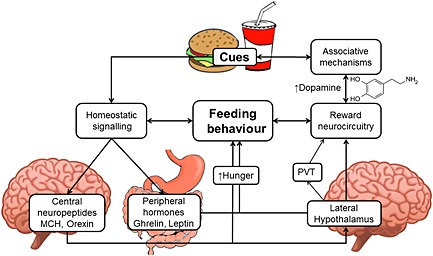Figure 2.

Food‐associated cues evoke feeding behaviours via effects on both homeostatic appetite regulating signals and reward neurocircuitry. Palatable food‐associated cues are assigned incentive salience and are capable of activating reward neurocircuitry (in particular, the mesolimbic dopamine system) leading to cravings and promotion of feeding behaviour in absence of metabolic demands. Appetite‐regulating peptides including ghrelin, orexin and MCH are capable of promoting hunger and evoke feeding behaviour; leptin and insulin signal satiety, and these signals interface with reward neurocircuitry via the lateral hypothalamus and through specific receptors located in the VTA. Satiety promoting hormones leptin and insulin may promote abnormal responsiveness to food cues by enhancing learning about sources of palatable food following ingestion, via specific hippocampal receptors and these are also influenced by orexigenic peptides. However, obesity induces insensitivity to insulin and leptin and little evidence indicates their cue‐conditioned anticipatory release. Food‐associated cues therefore may be capable of influencing appetite promoting peptide signals that are able to interface with reward neurocircuitry.
